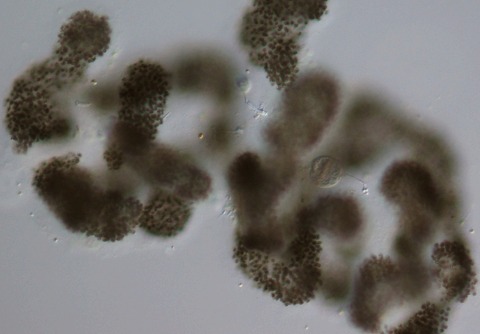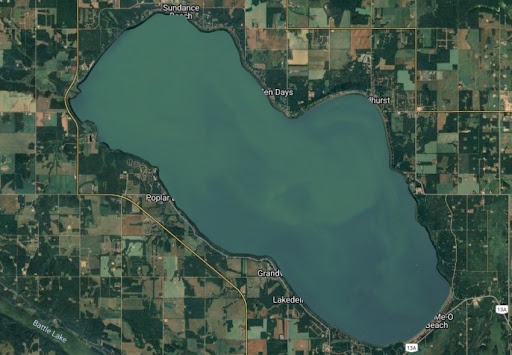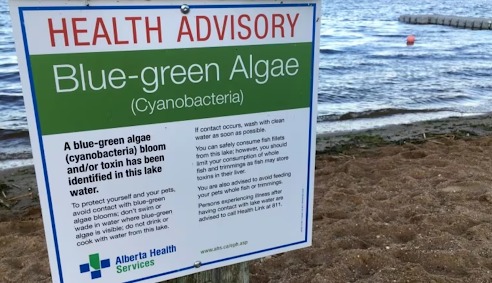Have you ever gone to visit your favorite Alberta lake for a swim, only to be turned away by a Blue-Green Algae Advisory? Every year, usually in July and August, many of our favorite lakes in Alberta become filled with blue-green algae, and we are told they are unsafe to swim in as a result. This year, algal blooms are popping up earlier than in previous years and we are left with many questions about the nature of blue-green algae and its effect on our environment and health. One thing is clear, Albertans will have to live with blue-green algal blooms for the foreseeable future. To find some answers the Alberta Biodiversity Monitoring Institute (ABMI) is collaborating with 10 other organizations to collect relevant data about algal blooms to better understand how they will impact our lakes, their ecosystems and our ability to enjoy them.
But why are blue green algae unsafe? Isn’t it natural to have blue green algae in lakes?
The answer to that is normally “yes,” but blue-green algae are not really algae, they’re actually a type of bacteria that are capable of photosynthesis! “Blue-green algae” is the common name for cyanobacteria that, like algae, obtain energy from the sun. Although there are many varieties of cyanobacteria that are naturally ubiquitous in aquatic environments, and perform many different important ecological functions, some types produce toxins that can negatively affect your health. When the conditions are right—hot sun, calm winds—cyanobacteria propagate, forming blooms that can take over a lake. Because of the toxins produced by these blooms, Alberta Health Services posts advisories when they form, letting the public- and their pets- know to not enter the lake in spots with visible blooms present.

Notorious toxic cyanobacterium Microcystis. Source: Rolf Vinebrook
Because of the toxins produced by these blooms, the lakes they occupy become unsafe for swimming and even wading. It’s when these blooms form that Alberta Health Services posts advisories, letting the public- and their pets- know to not enter the lake. Contact with the blooms in the water could result in rashes, sore throat, nausea, and vomiting, among a host of other unpleasant symptoms. These advisories can also result in major negative socio-economic impacts to Alberta’s recreation and tourism activities, to real estate values, and to Indigenous communities.
It’s well established that climate change and eutrophication contribute to the severity of these blooms, but there’s still a lot for us to learn about why, when, and how the blooms occur when they do. As a result, 11 organizations, including the ABMI, have been funded by Alberta Innovates to kick off a project titled Tracking and forecasting of cyanobacterial harmful algal blooms in Alberta using remote-sensing techniques under a changing climate, designed to spend the next few summers studying exactly that. The Alberta Lake Management Society has committed to collecting water samples at six Alberta lakes (Nakamun, Ethel, Pigeon, Wabamun, Sylvan, and Lac La Biche) over the next two summers, carefully timed to align with when the Sentinel satellites fly over the lakes because, believe it or not, these blooms are big enough they can be seen from space!
Eutrophication: the process of a body of water becoming increasingly enriched with nutrients like phosphorus and nitrogen, which are typically derived from human sources like septic systems, lawn fertilizers, and agricultural runoff. These nutrients follow both surface and groundwater pathways to enter lakes.

Collecting water samples at Pigeon Lake. Source: ALMS
The water samples will be analyzed by Rolf Vinebrooke’s lab at the University of Alberta, and when analyzed in conjunction with the satellite images and historical data about blooms by the ABMI’s Geospatial Centre, be used to develop a predictive model for cyanobacteria blooms in lakes across Alberta.
The main objective of this project is to enable for the first time in the province a high frequency tracking of the spatial and temporal dynamics of cyanobacterial blooms in several lakes, which is only possible using remote sensing via Earth Observation satellites. The knowledge gained from this exercise will advance our understanding of how cyanobacterial blooms have and continue to respond to various environmental factors (e.g., climatic variables), which will then enable the delivery of a predictive model for forecasting such events in the future. – Rolf Vinebrook
 The model will then be applied to an online mapping application, freely available to anyone, which can help users see if there is likely to be a bloom on their lake of interest or not, and to look at historical blooms. Although it will be several years before this web application is available (a beta version featuring exclusively Pigeon Lake is currently available), we believe it will be a powerful tool for Albertans. With the success of this project, we hope to continue to collect valuable information about blue-green algae blooms for many years to come.
The model will then be applied to an online mapping application, freely available to anyone, which can help users see if there is likely to be a bloom on their lake of interest or not, and to look at historical blooms. Although it will be several years before this web application is available (a beta version featuring exclusively Pigeon Lake is currently available), we believe it will be a powerful tool for Albertans. With the success of this project, we hope to continue to collect valuable information about blue-green algae blooms for many years to come.
Stay tuned to the ABMI’s newsletter and social media (Instagram, Twitter, LinkedIn and Facebook) to learn about how this project progresses over the next three years!
We’d like to thank Alberta Innovates for funding the work, and acknowledge all of the important project collaborators: the University of Alberta, the Alberta Lake Management Society, Alberta Health, Alberta Health Services, Environment and Climate Change Canada, Alberta Environment and Protected Areas, Associated Environmental Consultants Inc., the Pigeon Lake Watershed Association, Lac La Biche County, and the Wabamun Watershed Management Council.

